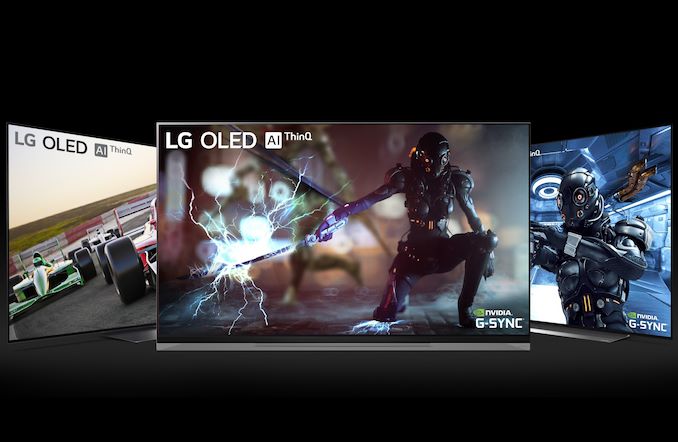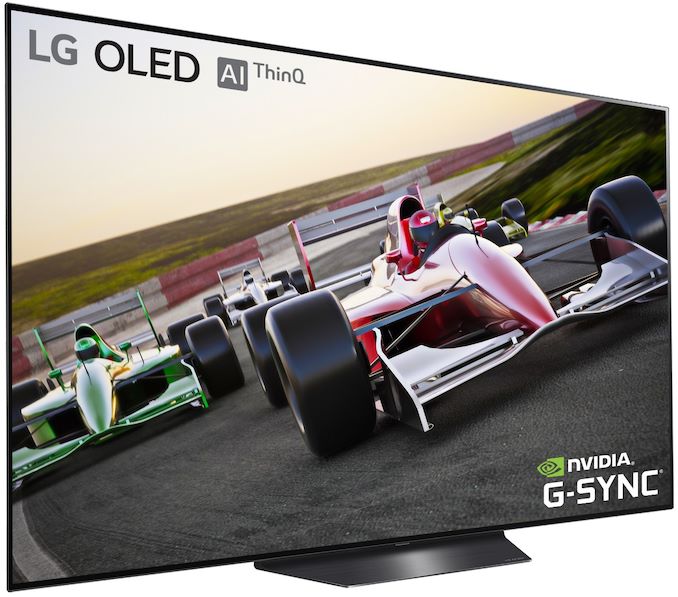LG’s E9, C9 & B9 OLED TVs to Get NVIDIA G-Sync via Firmware Update
by Anton Shilov on November 1, 2019 5:30 PM EST
Back in September, LG and NVIDIA teamed up to enable G-Sync variable refresh rate support on select OLED televisions. Starting this week and before the end of the year LG will issue firmware updates that add support for the capability on the company’s latest premium OLED TVs.
LG's 2019 OLED TVs have been making waves throughout the gaming community since their launch earlier this year. The TVs are among the first to support HDMI 2.1's standardized variable refresh rate technology, adding a highly demanded gaming feature to LG's already popular lineup of TVs. This has put LG's latest generation of TVs on the cutting edge, and, along with Microsoft's Xbox One X (the only HDMI-VRR source device up until now), the duo of devices has been serving as a pathfinder for HDMI-VRR in general.
Now, NVIDIA is getting into the game by enabling support for HDMI-VRR on recent video cards, as well as working with LG to get the TVs rolled into the company's G-Sync Compatible program. The two companies have begun rolling out the final pieces needed for variable refresh support this week, with LG releasing a firmware update for their televisions, while NVIDIA has started shipping a new driver with support for the LG TVs.
On the television side of matters, LG and NVIDIA have added support for the 2019 E9 (65 and 55 inches), C9 (77, 65 and 55 inches), and B9 (65 and 55 inches) families of TVs, all of which have been shipping with variable refresh support for some time now.
The more interesting piece of the puzzle is arguably on the video card side of matters, where NVIDIA is enabling support for the TVs on their Turing generation of video cards, which covers the GeForce RTX 20 series as well as the GeForce GTX 16 series of cards. At a high level, NVIDIA and LG are branding this project as adding G-Sync Compatible support for the new TVs. But, as NVIDIA has confirmed, under the hood this is all built on top of HDMI-VRR functionality. Meaning that as of this week, NVIDIA has just added support for HDMI's variable refresh standard to their Turing video cards.
While HDMI-VRR was introduced as part of HDMI 2.1, the feature is an optional extension to HDMI and is not contingent on the latest standard's bandwidth upgrades. This has allowed manufacturers to add support for the tech to HDMI 2.0 devices, which is exactly what has happened with the Xbox One X and now NVIDIA's Turing video cards. Which in the case of NVIDIA's cards came as a bit of a surprise, since prior to the LG announcement NVIDIA never revealed that they could do HDMI-VRR on Turing.
At any rate, the release of this new functionality gives TV gamers another option for smooth gaming on big-screen TVs. Officially, the TVs are part of the G-Sync Compatible program, meaning that on top of the dev work NVIDIA has done to enable HDMI-VRR, they are certifying that the TVs meet the program's standards for image stability (e.g. no artifacting or flickering). Furthermore, as these are HDR-capable OLED TVs, NVIDIA is also supporting HDR gaming as well, covering the full gamut of features available in LG's high-end TVs.
Ultimately, LG is the first TV manufacturer work with NVIDIA to get the G-Sync Compatible certification, which going into the holiday shopping season will almost certainly be a boon for both companies. So it will be interesting to see whether other TV makers will end up following suit.
Related Reading:











36 Comments
View All Comments
Hixbot - Saturday, November 2, 2019 - link
There should be enough bandwidth for 4k 8bit 4:2:0 at 120hz. But it doesn't work.lilkwarrior - Saturday, November 2, 2019 - link
With LG 2019 OLED having HDMI 2.1 along w/ Dolby Vision, HLG, TechniColor, & HDR10 HDR, this update practically makes the value proposition of all current "gaming TVs" & existing 4K@120hz gaming monitors extremely questionable—including the Alienware OLED that uses the same panel.Asus has their answer w/ the PA32UCG coming out next year (HDR1400+, 4K@120hz VRR, Dolby Vision, HLG, & HDR10 support, Thunderbolt 3, HDMI 2.1 rumored w/ its VRR support), but the other monitor manufacturers don't. monitors manufacturers creating specialized monitors for interactive monitor need to get their act together ASAP.
No self-respecting high-end 4K prosumer & high-end gamer should buy a 4K monitor without the following next year:
- Dolby Vision & HLG on top of HDR10 (ideally HDR10+ for dynamic HDR on the Web)
- HDMI 2.1; at least VRR or GTFO
- Thunderbolt 3 (charge laptop simultaneously that connect to it & only use one cable; USB4 merges in TB3 so you're good for years).
lilkwarrior - Saturday, November 2, 2019 - link
Displayport 2.0 is ideal, but will only become viable during the 2nd half of 2020.imaheadcase - Saturday, November 2, 2019 - link
uhh i got some bad news for you then..that monitor is delayed indefinitely. But you should know that because, well Asus always puts out press releases as proof of concept than actual products for a long awhile. I mean i got a bookmark showing a asus monitor i wanted for almost 2 years ago that just came out this year..and didn't come close to hype.Also Dolby vision and HDR? Are you serious? No self respecting person would even consider that for a monitor, especially since they don't sell well as it is as a gimmick.
crimsonson - Saturday, November 2, 2019 - link
HDR is a gimmick? It is one of the most important progress for display in years, probably since HDTV. More relevant than 3D, 4K, etc.Not sure how you can even say that. The current standard of SDR at 100 nits is decades old. Even current low end monitors can do 200+ nits.
Yojimbo - Monday, November 4, 2019 - link
To some people, everything that doesn't take over the world in a year is a gimmick.Yojimbo - Monday, November 4, 2019 - link
Examples: VR is a gimmick, ray tracing is a gimmick, HDR is a gimmick, television is a gimmick, etc.andysab - Saturday, November 2, 2019 - link
Is there any chance this firmware update will eventually make it to the 2018 OLED line as well, or are there technical limitations preventing it?crimsonson - Saturday, November 2, 2019 - link
My guess they are not even going to explore it. Technically possible or not, they are going to try sell 2019 models this Xmas season. It sucks but that is capitalism for you.This might tip the scale for me as I was considering Samsung QLED TV for living room. OLED provides better blacks but LCD can be brighter and stable in terms of color rendering. OLEDs age incredibly fast.
Not sure though if I will game with the big TV instead of my desktop monitor. So not sure how useful this will be for me.
HammerStrike - Saturday, November 2, 2019 - link
A point in LG’s favor is that the E8/C8/B8 series panels and earlier are all HDMI 2.0. They’d never be able to go beyond 60hz with a 4K signal, and presumably they are using a different HDMI chipset from the 9 series panels; assuming it could be made to work with HDMI-VRR they’d have to engineer a second solution for a product line they no longer sell and would limited in its headline mode (4K).Not saying it wouldn’t be welcome but it’s understandable if they are focusing on their current line that can support it in full. Personally eyeing up a C9 77” - if it goes below $5k for Black Friday I might have to pull the trigger.